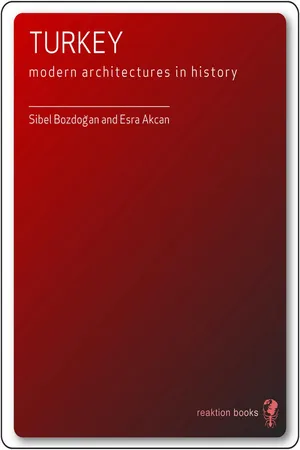
- English
- ePUB (mobile friendly)
- Available on iOS & Android
About this book
Turkey: Modern Architectures in History offers a journey through the iconic buildings of Turkey that begins with the end of World War I, when the new Turkish Republic was born out of the disintegration of the Ottoman Empire, includes its democratization in the midst of the Cold War's competing ideologies, and concludes with the present day, in which Turkey continues to be dramatically transformed through globalization, economic integration, and a renewed appreciation for its Islamic and Ottoman heritage. Sibel Bozdogan and Esra Akcan explore modern institutional masterpieces and architect-designed buildings through the decades. Their focus includes informal residential plans, and they discuss how these have evolved from small settlements to colossal urban quarters that exist at a slippery threshold of legality. This richly informative history of Turkey's built environment goes beyond typical surveys of Western modern architecture and is unique in tackling the issue of the modern and contemporary periods that are often omitted in studies of Islamic art and architecture. Offering a perceptive overview of modern Turkish architecture, this book places it within the larger social, political, and cultural context of the country's development as a modern nation in the twentieth century.
Frequently asked questions
- Essential is ideal for learners and professionals who enjoy exploring a wide range of subjects. Access the Essential Library with 800,000+ trusted titles and best-sellers across business, personal growth, and the humanities. Includes unlimited reading time and Standard Read Aloud voice.
- Complete: Perfect for advanced learners and researchers needing full, unrestricted access. Unlock 1.4M+ books across hundreds of subjects, including academic and specialized titles. The Complete Plan also includes advanced features like Premium Read Aloud and Research Assistant.
Please note we cannot support devices running on iOS 13 and Android 7 or earlier. Learn more about using the app.
Information
References
Introduction
chapter one: Architecture of Revolution
Table of contents
- Front Cover
- Half Title
- Title Page
- Copyright
- Contents
- Introduction
- one Architecture of Revolution
- two Building for the Modern Nation State
- three The Modern House
- four Populist Democracy and Post-war Modernism
- five Housing in the Metropolis
- six Architecture under Coups d'État
- seven Postmodern Landscapes in Post-Kemalist Turkey
- eight The Illegal City and New Residential Segregation
- nine The ‘Young Turk Architects’ of Globalization
- References
- Select Bibliography
- Acknowledgements & Photo Acknowledgements
- Index